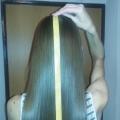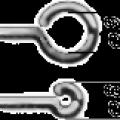Invisible color change when crocheting in the round with single crochets. Multi-color knitting Invisible color transition when crocheting in the round
When knitting many amigurumi toys it is required to change the color of the thread and with the usual tying of a new thread, the knitting does not look very beautiful, on the new row in the new color, half-loops of the “old” color are visible. This master class shows 2 ways to change colors when knitting toys so that the transition looks clean and neat. The first method demonstrates the change of thread when knitting in a spiral, and the second - when knitting in closed rows.
1 way: knitting in a spiral
We knit to the place where you want to change the color. Now insert the hook into the loop of the next column, grab the thread of the old color and pull it up. You have two loops of the old color on your hook.
Now we grab a new thread with a hook and pull it through the loops on the hook.

We insert the hook into the next loop, grab the thread, pull it out and pull it through the loop on the hook (it turned out to be a half-column).


2 way: knitting in closed circular rows
After completing the row in the old color, do not close it with a connecting loop.
Remove a loop from the hook and insert an empty hook into the loop in which you would close the row.

Now take the loop off the hook and put it on the hook from front to back.

Now put a thread of a new color on the hook and pull it out. Do air loop lifting and then knit a row as usual.

For more clarity, you can see
how to switch to a thread of another color crochetSleight of hand, and no cheating. The easiest of all methods. There are NO dots and steps.!
1.
2.
We knit the last column in the row. We remove the loop from the hook. We introduce the hook into the top of the lifting chain, and then into the left loop. And we knit them in one fell swoop with a thread of a different color. Those. it turns out the usual connecting column, but the loops are reversed.
This method allows you to knit without breaking the thread. But ideally goes only on RLS. So you can knit in one color - the seam also looks better. On CH - the lifting chain slightly turns away from knitting, but still the result is not bad.
I have one more a good option so as not to tear off the thread - but the effect is the same. Finish the SS series. Pull a larger loop and pull the ball through it, tighten until it stops. Those. you no longer have a free loop. With a new thread, start the next row with a lifting chain. The seam on the multi-colored rows will be without unnecessary inclusions. But dissolving such a thing is problematic.
If you still knit, as usual - the last loop in front of the connecting post should be pulled as tight as possible, it will help a little.

You have probably already encountered or will encounter such a problem that when knitting a part in a circle with two colors, the line of junction of colors does not turn out to be even, but twists in a spiral (shifts to the right). How to attach to start a new color?
Let's start by introducing a new color.
We introduce a new color not from the column indicated in the diagram or in the description, but in the previous column, i.e. knitting the last crochet of the column with a new color (as shown in the photo below).

2.
We draw the first thread on the wrong side, interlacing it with the second one or simply pulling it freely (sometimes dark threads can shine through through light threads, then it is better to use the second method). We return the first thread in the same way as the second one was introduced.
5.
6.
7.
In order for the color junction line to be even and not move anywhere, the last column of the first color should be knitted not into a loop, but into the single crochet of the previous row itself (as shown in the photo below), and also knit the first column of the second color.
10.
11.
12.
If the toy is small, you can knit it completely column in column, as the Japanese do.

14.

Replacing colors in jacquard knitting requires competent crochet thread change. This is not so difficult to do, but you need to know some of the nuances.
Consider several stages of colored knitting of a flat fabric according to the “single crochet” scheme.
Knitting flat pattern with white and black pattern
The product is knitted according to the pattern "4 white single crochet", 5-6 black single crochet". When knitting, remember that in the last loops of the previous column, the color changes. It happens in the following way. First, three white columns are knitted, the 4th is knitted from the loop (there should be 2 loops on the hook), the black thread is picked up by the hook. The 2 loops remaining on the hook are knitted with black thread. Thus, the black thread is pulled through 2 loops at once.
After that, you need to knit 5-6 black loops and repeat the same steps as with the 4th white one. After the row of the canvas is knitted, you can see that there will be no color shift with this knitting, because the last loops will be the “tops” of the next ones (for example, the 4th in relation to the 5th).
Fastening thread ends
With frequent thread changes when crocheting in multi-color crochet patterns, the question often arises of how best to secure the ends of the threads. by the most in a simple way is the fastening of the threads from the wrong side of the product.
At the same time, most knitters do not tie the ends of colored threads to each other at all. When a new color is needed, the thread is simply picked up with a hook. The short end is held with a finger and laid along the already knitted row, that is, they are knitted into the fabric itself. This method allows you to make the wrong side of the product more professional, avoiding unnecessary knots and tubercles.
Although the method of knitting the ends of the thread is not suitable for every yarn. If the threads are very slippery, it is better to use knots so that the tips do not accidentally pop out. In the case when the product is knitted from wool, bulk cotton, wool mixture or acrylic, any method of fixing the tips can be used. If the tips are tied, they can be burned or glued.
Alternating working and unused threads
In the process of knitting, knitters are faced with the fact that one of the threads is not used in the knitting process. So that it does not sag, it must also be hidden. For this, the same method is used as the one used to secure the ends of the threads. The "resting" thread is laid along the row, which is now being knitted. New columns are made around this thread. If necessary, the threads are changed.

When you can use one or more balls. It all depends on the preference of the knitter. Many prefer to use new balls so that a thread of a different color does not shine through. In addition, if the thread is pulled through the product, the fabric becomes denser. To avoid this, it is better to use new balls at each color change.
Sometimes not even a ball is taken, but a thread of the required length is torn off. In this way, tangling of threads can be avoided. Separate threads are used for knitting small details in the product design.
The methods proposed in this article for replacing the thread in jacquard crochet are not exhaustive. Each knitter has her own methods for changing thread. But even these methods can greatly help both beginners and professional knitters to knit a beautiful and high-quality product.

Changing a thread of a different color is necessary when making pictures according to embroidery patterns, as well as in models of children's and women's clothing, and other home decor items.
Thread change at the end of the row





In the last loop of the row we do not knit a double crochet, i.e. Knit until there are 2 loops left on the hook.
We pick up the thread of the new color and knit the remaining 2 loops with it.
Thread change in the middle of the row












When knitting various dense patterns, sometimes you have to change the thread in the middle of the row.
Similarly, we knit a double crochet until the last step, until 2 loops remain on the hook.
We pick up a thread of a different color and knit these 2 loops, then continue knitting with a thread of a different color.
This way you avoid color shifting when crocheting.
When knitting jacquard patterns, a non-working thread is usually pulled along a row, at a distance of 3-4 loops, and after changing the color, the working and unused threads are simply swapped.
With a green thread, we knit a double crochet until the last step, until 2 loops remain on the hook.
We pick up the orange thread and knit 2 loops with it.
We make a crochet, (we place the green thread along the row), insert the hook into the loop, grab the thread and pull out a new loop (as you can see, the green thread should be inside the columns), knit the double crochet and then continue knitting, changing the colors of the thread according to your drawing.
This page is found by queries:
- alternating yarn colors when crocheting
- crochet yarn replacement
- how to alternate threads when crocheting
- how to alternate yarns when crocheting
Multicolor knitting is knitting with yarn of two or more colors. According to the method of execution, jacquard knitting can be distinguished and, which are commonly called lazy or false jacquards. The classic ones are done in stockinette stitch with a change in the colors of the yarn and pulling the threads on the wrong side of the work. Another type of jacquard knitting that came from Sweden is bohus knitting, which is performed both with front and back loops (on the front side). Pulling the threads on the wrong side narrows the work, so you need to carefully monitor the tension of these threads, do not tighten them, otherwise the jacquard pattern will not turn out beautiful. In the photo - mittens knitted with a jacquard pattern (click on the picture if you want to see the diagram).
The technique of false jacquard is that each row is knitted with yarn of the same color, there is no color change in the row. The pattern is usually formed by . The false jacquard technique is easier to perform, does not require much experience, and such patterns can be recommended to beginner knitters.
But no matter what technique you use, in multicolor knitting there is always a need to attach yarn of a different color at the beginning or in the course of knitting a row.
Let's look at some tricks that may come in handy for multi-color knitting.
Joining a thread at the beginning of a row
The thread of the new color is grabbed together with the thread of the previous color and the two threads are knitted together in the edge loop of the row that precedes the row in which the yarn of the new color (in this case, burgundy) is introduced.

Joining a new color yarn at the beginning of the row, the first stage
The work is turned over, the edge loop is removed as usual, and then the row is knitted with a new color of yarn. The remaining "tail" is crocheted into edge loops.

Joining a new color yarn at the beginning of the row, the second stage
Change yarn color at the beginning of the row
Sometimes it becomes necessary to change colors frequently at the beginning of a row when knitting with yarn of two colors, especially when knitting lazy jacquards. In this case, this method is suitable for decorating the side edge of the canvas: the edge loops are knitted with yarn of both colors, then the work is turned over, and the next row is knitted desired color. It turns out a neat, though thicker, side edge of the canvas.

Yarn color change at the beginning of the row: side hem
Another way to change colors at the beginning of a row- knit the last loop of the front row behind the front wall, turn the work over, and do not remove the edge loop, as usual, and also knit the front one, but of a different color, while the working thread should go from above.

Thread change at the beginning of the row to form a decorative edge
As a result, we get a beautiful decorative edge, which is suitable for knitting scarves. But in order for the tension of the fabric along the side edges of the part to be the same, at the other end of the row, the first edge loop must also be knitted with the front one, and not removed.

If there is a large distance between the rows in which the color changes occur, then it is better to stretch the thread of the non-working color through the broaches between the penultimate and last (edge) loops.

Connecting the ends of the threads
Often there is a need to connect the ends of the threads, and not only with multi-color knitting, but also simply when you need to start from a new ball. In this case, you can tie the ends with a special knot, when the ends of the threads are twisted twice at the second stage of tying the knot (see more). Such a knot is not untied and turns out to be small:

With the same knot, you can not only tie the ends of the yarn, but also tie a yarn of a different color in a row, if you need to introduce a new color when jacquard knitting.

Attaching a thread of a new color in a row
You can connect the threads without a knot by twisting the ends. In this case, several loops are knitted in two threads, so the yarn must be thin enough so that these loops do not stand out too much from the general background.

Fastening long broaches of threads in classic jacquards
When knitting classic jacquards, sometimes too long broaches are formed, which create inconvenience when worn. finished product. If there are more than 4 loops between color changes, the broaches are interlaced with a working thread.

Interlacing the broach thread with the working thread when working from the front side

 Men's haircut with scissors or a typewriter, what to choose?
Men's haircut with scissors or a typewriter, what to choose? AT Kalinin Puzzles from buttons and threads; wire, twine and lace. How to make a trick with a thread and a button on your fingers How to make a toy button with a thread
AT Kalinin Puzzles from buttons and threads; wire, twine and lace. How to make a trick with a thread and a button on your fingers How to make a toy button with a thread Felting wool for beginners - do-it-yourself soft hedgehog
Felting wool for beginners - do-it-yourself soft hedgehog